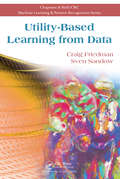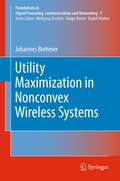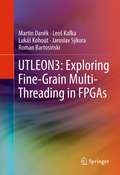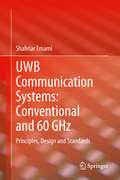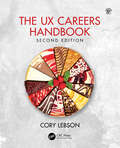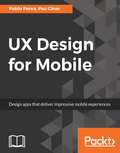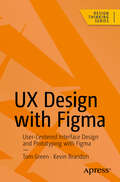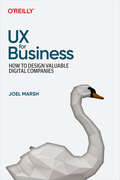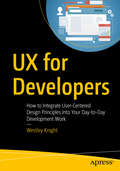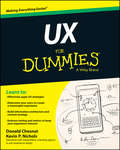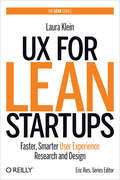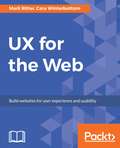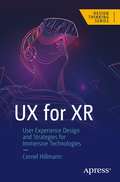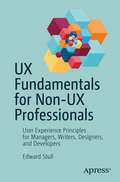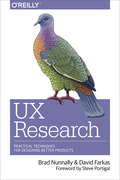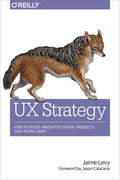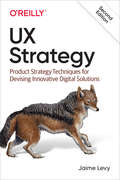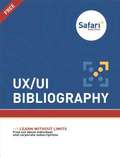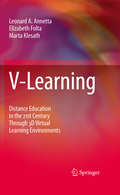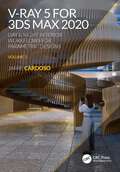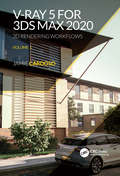- Table View
- List View
Utility-Based Learning from Data
by Craig Friedman Sven SandowUtility-Based Learning from Data provides a pedagogical, self-contained discussion of probability estimation methods via a coherent approach from the viewpoint of a decision maker who acts in an uncertain environment. This approach is motivated by the idea that probabilistic models are usually not learned for their own sake; rather, they are used t
Utility Maximization in Nonconvex Wireless Systems
by Johannes BrehmerThis monograph develops a framework for modeling and solving utility maximization problems in nonconvex wireless systems. The first part develops a model for utility optimization in wireless systems. The model is general enough to encompass a wide array of system configurations and performance objectives. Based on the general model, a set of methods for solving utility maximization problems is developed in the second part of the book. The development is based on a careful examination of the properties that are required for the application of each method. This part focuses on problems whose initial formulation does not allow for a solution by standard methods and discusses alternative approaches. The last part presents two case studies to demonstrate the application of the proposed framework. In both cases, utility maximization in multi-antenna broadcast channels is investigated.
UTLEON3: Exploring Fine-Grain Multi-Threading in FPGAs
by Martin Daněk Lukáš Kohout Jaroslav Sýkora Roman Bartosiński Leoš KafkaThis book describes a specification, microarchitecture, VHDL implementation and evaluation of a SPARC v8 CPU with fine-grain multi-threading, called micro-threading. The CPU, named UTLEON3, is an alternative platform for exploring CPU multi-threading that is compatible with the industry-standard GRLIB package. The processor microarchitecture was designed to map in an efficient way the data-flow scheme on a classical von Neumann pipelined processing used in common processors, while retaining full binary compatibility with existing legacy programs.
UWB Communication Systems: Conventional and 60 GHz
by Shahriar EmamiIn this book the author examines 60 GHz and conventional UWB. The book introduces the fundamentals, architectures, and applications of unified ultra wideband devices. The material includes both theory and practice and introduces ultra wideband communication systems and their applications in a systematic manner. The material is written to enable readers to design, analyze, and evaluate UWB communication systems.
The UX Careers Handbook
by Cory LebsonThis second edition of The UX Careers Handbook offers you all the great advice of the first edition—freshly updated—plus a new chapter on critical soft skills, much more on becoming a UX leader, and a 17th user experience (UX) career pathway. The UX Careers Handbook, Second Edition, offers you an insider's advice on learning, personal branding, networking skills, building your resume and portfolio, and actually landing that UX job you want, as well as an in-depth look at what it takes to get into and succeed in a UX career. Whether your interests include design, information architecture, strategy, research, UX writing, or any of the other core UX skillsets, you'll find a wealth of resources in this book. The book also includes: Insights and personal stories from a range of industry-leading UX professionals to show you how they broke into the industry and evolved their own careers over time Activities and worksheets to help you make good decisions and build your career Along with the book, you can explore its companion website with more resources and information to help you stay on top of this fast-changing field. Not only for job seekers, The UX Careers Handbook, Second Edition, is a must-have for Employers and recruiters who want to better understand how to hire and keep UX staff Undergraduate and graduate students thinking about their future careers Professionals in other careers who are thinking about starting to do UX work Cory Lebson has been a UX consultant and user researcher for over two decades. He is Principal and Owner of a small UX research consultancy, a builder of UX community, and a past president of the User Experience Professionals Association (UXPA). Not only a practitioner of UX, Cory teaches and mentors to help professionals grow their UX skills and conducts regular talks and workshops on topics related to both UX skills and career development.
UX Design for Mobile
by Pablo Perea Pau GinerThis book is for designers, developers and product managers interested in creating successful apps. Readers will be provided with a process to produce, test and improve designs based on best practices.
UX Design with Figma: User-Centered Interface Design and Prototyping with Figma (Design Thinking)
by Tom Green Kevin BrandonMaximize Figma’s arsenal of tools and plugins within a team-based collaborative environment and accelerate your company’s decision making. This book will show you where Figma fits into the user experience (UX) design process from documentation to developer handoff. Since its release as a browser-based design tool in 2016, Figma has fast become the de facto UX Design tool for the industry mainly due to its accessibility and ease of use. As you move through the book you will learn where Figma fits in the UX process. For example, using FigJam (an online whiteboard) for brainstorming, and creating interactive prototypes for mobile devices, tablets, and web sites. You’ll also see how Figma is used to create and integrate with design systems, and how variables, when applied to design system components, can accelerate the design and development workflow. With the help of step-by-step examples, and using Figma’s tools and templates, you’ll create artifacts such as Flow and Journey diagrams, Personas, and wireframes. From there you will explore other design and interactivity features, and how to prepare a Figma file for handoff to a development team. This book is your roadmap to utilizing Figma, the industry’s fastest growing collaborative design tool for building meaningful products. What You Will Learn Create interactive prototypes Test and submit designs for team review Understand the collaborative workflow involved in an UX project Prepare common UX documentation Who This Book Is For Designers, developers, and UX specialists with little-to-no Figma experience who are looking to integrate it within their workflows, and intermediate Figma users who are just starting to become involved in the collaborative UX workflow.
UX for Beginners: A Crash Course in 100 Short Lessons
by Joel MarshApps! Websites! Rubber Ducks! Naked Ninjas! This book has everything. If you want to get started in user experience design (UX), you've come to the right place: 100 self-contained lessons that cover the whole spectrum of fundamentals.Forget dry, technical material. This bookâ??based on the wildly popular UX Crash Course from Joel Marshâ??s blog The Hipper Elementâ??is laced with the author's snarky brand of humor, and teaches UX in a simple, practical way. Becoming a professional doesnâ??t have to be boring.Follow the real-life UX process from start-to-finish and apply the skills as you learn, or refresh your memory before the next meeting. UX for Beginners is perfect for non-designers who want to become designers, managers who teach UX, and programmers, salespeople, or marketers who want to learn more.Start from scratch: the fundamentals of UXResearch the weird and wonderful things users doThe process and science of making anything user-friendlyUse size, color, and layout to help and influence usersPlan and create wireframesMake your designs feel engaging and persuasiveMeasure how your design works in the real worldFind out what a UX designer does all day
UX for Business: How to Design Valuable Digital Companies
by Joel MarshMany UX designers are surprised to learn that much of the job isn't about drawing things. It's about knowing what to draw and how to convince people to build it. Whether you're a one-person design team making products from scratch or a C-level product leader managing many products and strategies, UX for Business is your missing guide to real-world business design.You'll not only learn how to think about design as a professional but also discover how design can move the needle for your entire company. Author Joel Marsh helps you understand stakeholders, business models, the process of designing valuable solutions, dangerous choices that can ruin a product, and how to gain the attention your work deserves. You'll also explore the principles of designing common types of digital products and services, from portfolio sites to social networks to ecosystems.With this book, you'll learn:How to design the right things by understanding value, diagnostics, and probabilityHow to conduct UX research and analysis without the luxury of time or moneyThe most important aspects of common digital business modelsMethods for getting things done under less-than-ideal circumstancesHow to avoid common pitfalls caused by inexperience
UX for Developers: How to Integrate User-Centered Design Principles Into Your Day-to-Day Development Work
by Westley KnightBecome more mindful of the user when building digital products, and learn how to integrate a user-centered approach into your thinking as a web or app developer. This book shows you how the user experience is the responsibility of everyone involved in creating the product and how to redefine development principles when building user-centered digital products.There are still many organizations that are not design driven, and the gap between stereotypical design and development teams needs to be bridged in order to build digital products that cater to the needs of real people. We are at a point where we see organizations that cannot bring the user experience into their core thinking falling behind their competitors. You'll see how to increase the level of UX maturity within any organization by tackling what is possibly the biggest stumbling block that stands between design and development: putting user needs ahead of system efficiency. UX for Developers shows how you can adjust your focus in order to be more mindful of the user when building digital products. Learn to care about what you build, not just for the system’s sake, but for those who will use what you build.What You'll LearnUnderstand what it means to build websites and applications for the user, rather than from a developer’s perspective.Review the soft skills required to build more usable digital productsDiscover the tools and techniques to adopt a user-focused approach to development.Improve communication throughout design and development, especially between developers and non-developers.Who This Book Is ForPrimary audience is Web/app developers that are looking to understand what it takes to build usable digital products. Secondary audience is UX Designers who are looking to understand the viewpoint of developers; Project managers and stakeholders who need to facilitate better working relationships between developers and designers.
UX For Dummies
by Donald Chesnut Kevin NicholsGet up to speed quickly on the latest in user experience strategy and designUX For Dummies is a hands-on guide to developing and implementing user experience strategy. Written by globally-recognized UX consultants, this essential resource provides expert insight and guidance on using the tools and techniques that create a great user experience, along with practical advice on implementing a UX strategy that aligns with your organisation's business goals and philosophy. You'll learn how to integrate web design, user research, business planning and data analysis to focus your company's web presence on the needs of your customers, gaining the skills you need to be effective in the field of user experience design.Whether it's the interface, graphics, industrial design, physical interaction or a user manual, being anything less than on point can negatively affect customer satisfaction and retention. User experience design fully encompasses traditional human-computer interaction design, and extends it to address all aspects of a product or service as perceived by users. UX For Dummies provides comprehensive guidance to professionals looking to understand and apply effective UX strategies.Defines UX and offers assistance with determining users and modelling the user experienceProvides details on creating a content strategy and building information architecturesExplores visual design and designing for specific channelsDelves into UX testing and methods for keeping your site relevantThe UX field is growing rapidly as companies realise that meeting your business goals requires a web presence aligned with customer needs. This alignment demands smart strategy and even smarter design. Consultants, designers and practitioners must all be on board if the result is to be cohesive and effective. UX For Dummies provides the information and expert advice you need to get up to speed quickly.
UX for Lean Startups: Faster, Smarter User Experience Research and Design
by Laura KleinGreat user experiences (UX) are essential for products today, but designing one can be a lengthy and expensive process. With this practical, hands-on book, you'll learn how to do it faster and smarter using Lean UX techniques. UX expert Laura Klein shows you what it takes to gather valuable input from customers, build something they'll truly love, and reduce the time it takes to get your product to market. No prior experience in UX or design is necessary to get started. If you're an entrepreneur or an innovator, this book puts you right to work with proven tips and tools for researching, identifying, and designing an intuitive, easy-to-use product. Determine whether people will buy your product before you build it Listen to your customers throughout the product's lifecycle Understand why you should design a test before you design a product Get nine tools that are critical to designing your product Discern the difference between necessary features and nice-to-haves Learn how a Minimum Viable Product affects your UX decisions Use A/B testing in conjunction with good UX practices Speed up your product development process without sacrificing quality
UX for Lean Startups: Faster, Smarter User Experience Research and Design
by Laura Kleinp>Great user experiences (UX) are essential for products today, but designing one can be a lengthy and expensive process. With this practical, hands-on book, you’ll learn how to do it faster and smarter using Lean UX techniques. UX expert Laura Klein shows you what it takes to gather valuable input from customers, build something they’ll truly love, and reduce the time it takes to get your product to market.No prior experience in UX or design is necessary to get started. If you’re an entrepreneur or an innovator, this book puts you right to work with proven tips and tools for researching, identifying, and designing an intuitive, easy-to-use product.Determine whether people will buy your product before you build itListen to your customers throughout the product’s lifecycleUnderstand why you should design a test before you design a productGet nine tools that are critical to designing your productDiscern the difference between necessary features and nice-to-havesLearn how a Minimum Viable Product affects your UX decisionsUse A/B testing in conjunction with good UX practicesSpeed up your product development process without sacrificing quality
UX for the Web
by Marli Ritter Cara WinterbottomLearn how UX and design thinking can make your site stand out from the rest of the internet. About This Book • Learn everything you need to know about UX for your Web Design. • Design B2B, B2C websites that stand out from the competitors with this guide • Enhance your business by improving customer accessibility and retention. Who This Book Is For If you're a designer, developer, or just someone who has the desire to create websites that are not only beautiful to look at but also easy to use and fully accessible to everyone, including people with special needs, UX for the Web will provide you with the basic building blocks to achieve just that. What You Will Learn • Discover the fundamentals of UX and the User-Centered Design (UCD) Process. • Learn how UX can enhance your brand and increase user retention • Learn how to create the golden thread between your product and the user • Use reliable UX methodologies to research and analyze data to create an effective UX strategy • Bring your UX strategy to life with wireframes and prototypes • Set measurable metrics and conduct user tests to improve digital products • Incorporate the Web Content Accessibility Guidelines (WCAG) to create accessible digital products In Detail If you want to create web apps that are not only beautiful to look at, but also easy to use and fully accessible to everyone, including people with special needs, this book will provide you with the basic building blocks to achieve just that. The book starts with the basics of UX, the relationship between Human-Centered Design (HCD), Human-Computer Interaction (HCI), and the User-Centered Design (UCD) Process; it gradually takes you through the best practices to create a web app that stands out from your competitors. You'll also learn how to create an emotional connection with the user to increase user interaction and client retention by different means of communication channels. We'll guide you through the steps in developing an effective UX strategy through user research and persona creation and how to bring that UX strategy to life with beautiful, yet functional designs that cater for complex features with micro interactions. Practical UX methodologies such as creating a solid Information Architecture (IA), wireframes, and prototypes will be discussed in detail. We'll also show you how to test your designs with representative users, and ensure that they are usable on different devices, browsers and assistive technologies. Lastly, we'll focus on making your web app fully accessible from a development and design perspective by taking you through the Web Content Accessibility Guidelines (WCAG). Style and Approach This is an easy-to-understand step-by-step guide with full of examples to that will help you in creating good UX for your web applications.
UX for XR: User Experience Design and Strategies for Immersive Technologies (Design Thinking)
by Cornel HillmannExtending traditional digital platforms to the new frontier of extended reality (XR) requires taking into account what best practices, new concepts, and conventions have been established and what learnings can be brought forward from case studies involving industry leaders. By looking at practical examples from the field of handheld AR breakthroughs, virtual reality (VR) success stories and experimental interaction concept of pioneering XR platforms, you'll see how it's possible to map out a framework of user experience (UX) guidelines to close in on opportunities and challenges that lay ahead.This book defines, identifies, and analyzes UX practices for XR environments and reviews the techniques and tools for prototyping and designing XR user interactions. You'll approach the design for experiential state and spatial cognition, using established UX key performance indicators, while taking into account the social dynamics, emotional framework and wider industry context.UX design and strategy for the XR space is a new frontier, so UX for XR focuses on case studies and industry research to illustrate the relationship between UX design and the growth of immersive technologies. Practical examples will demonstrate how you should apply UX design principles using designing interactions in XR by identifying the importance of spaces, senses and storyboarding.What You'll LearnExplore the challenges and opportunities of designing for XRSee how spatial interaction is revolutionizing human computer interactionExamine sensory input and interaction beyond the screenWork with 3D Interaction Design and build a strong 3D UXUnderstand VR and augmented reality essentials for emotion-rich user experiencesApply UX research techniques for the XR spaceWho This Book Is ForThis book is primarily for UX designers, consultants, and strategists; XR developers; and media professionals
UX Fundamentals for Non-UX Professionals: User Experience Principles for Managers, Writers, Designers, and Developers
by Edward StullDemystify UX and its rules, contradictions, and dilemmas. This book provides real-world examples of user experience concepts that empower teams to create compelling products and services, manage social media, interview UX candidates, and oversee product teams.From product decisions to performance reviews, your ability to participate in discussions about UX has become vital to your company's success as well as your own. However, UX concepts can seem complex. Many UX books are written by and for UX professionals. UX Fundamentals for Non-UX Professionals serves the needs of project managers, graphic designers, copyeditors, marketers, and others who wish to understand UX design and research.You will discover how UX has influenced history and continues to affect our daily lives. Entertaining real-world examples demonstrate what a massive, WWII-era tank teaches us about design, what a blue flower tells us about audiences, and what drunk marathoners show us about software.What You'll LearnKnow the fundamentals of UX through real-world examples Acquire the skills to participate intelligently in discussions about UX design and researchUnderstand how UX impacts business, including product, pricing, placement, and promotion as well as security, speed, and privacyWho This Book Is ForProfessionals who work alongside UX designers and researchers, including but not limited to: project managers, graphic designers, copyeditors, developers, and human resource professionals; and business, marketing, and computer science students seeking to understand how UX affects human cognition and memory, product pricing and promotion, and software security and privacy.
UX Research: Practical Techniques for Designing Better Products
by Brad Nunnally David FarkasOne key responsibility of product designers and UX practitioners is to conduct formal and informal research to clarify design decisions and business needs. But there’s often mystery around product research, with the feeling that you need to be a research Zen master to gather anything useful. Fact is, anyone can conduct product research. With this quick reference guide, you’ll learn a common language and set of tools to help you carry out research in an informed and productive manner.This book contains four sections, including a brief introduction to UX research, planning and preparation, facilitating research, and analysis and reporting. Each chapter includes a short exercise so you can quickly apply what you’ve learned.Learn what it takes to ask good research questionsKnow when to use quantitative and qualitative research methodsExplore the logistics and details of coordinating a research sessionUse softer skills to make research seem natural to participantsLearn tools and approaches to uncover meaning in your raw dataCommunicate your findings with a framework and structure
UX Strategy: How to Devise Innovative Digital Products that People Want
by Jaime LevyUser experience (UX) strategy requires a careful blend of business strategy and UX design, but until now, there hasn't been an easy-to-apply framework for executing it. This hands-on guide introduces lightweight strategy tools and techniques to help you and your team craft innovative multi-device products that people like to use.Whether you're an entrepreneur, UX/UI designer, product manager, or part of an intrapreneurial team, this book teaches simple-to-advanced strategies that you can use in your work right away. Along with business cases, historical context, and real-world examples throughout, you'll also gain different perspectives on the subject through interviews with top strategists.Define and validate your target users through provisional personas and customer discovery techniquesConduct competitive research and analysis to explore a crowded marketplace or an opportunity to create unique valueFocus your team on the primary utility and business model of your product by running structured experiments using prototypesDevise UX funnels that increase customer engagement by mapping desired user actions to meaningful metrics
UX Strategy: How To Devise Innovative Digital Products That People Want
by Jaime LevyUser experience (UX) strategy lies at the intersection of UX design and business strategy, but until now, there hasn't been an easy-to-apply framework for executing it. This hands-on guide introduces lightweight product strategy tools and techniques to help you and your team devise innovative digital solutions that people want.Author Jaime Levy shows UX/UI designers, product managers, entrepreneurs, and aspiring strategists simple to advanced methods that can be applied right away. You'll gain valuable perspective through business cases and historical context. This second edition includes new real-world examples, updated techniques, and a chapter on conducting qualitative online user research.Define value propositions and validate target users through provisional personas and customer discovery techniquesExplore marketplace opportunities by conducting competitive research and analysisDesign experiments using rapid prototypes that are focused on the business modelConduct online user research to gain valuable insights quickly on any budgetTest business ideas and validate marketing channels by running online advertising and landing page campaigns
UX Style Frameworks: Creating Collaborative Standards
by Marti GoldUX Style Frameworks is a practical guide for the hands-on creation of a Style Framework. This new and collaborative documentation format combines different departments’ standards and style guides into a single, unified, and accessible source for all employees. Marti Gold defines Style Frameworks for web and user experience designers, showing what and how much information goes into a style framework. As UX designers and creative directors are charged with ensuring a business’s web and mobile output are in line with branding standards, the unification of style guides, code libraries, and pattern libraries is an important aspect to dissolving "design siloes" and creating a unified brand. Each section in the book will identify the current pain points and common internal practices that result in standards documents being ignored and eventually becoming obsolete. UX Style Frameworks provides solutions on creating Style Frameworks that evolve to keep standards current, ultimately resulting in more cohesive brand and product designs. Key features: Offers a fully functional companion website with a complete Style Framework, showing all examples featured in the book and available for download so that users can start their own Style Framework. Each section includes information about addressing company politics and policies to help readers navigate those murky waters to ensure buy-in and establishment of Style Frameworks. Includes case studies that showcase success stories where Style Frameworks were implemented and not-so-successful stories where Style Frameworks were needed, giving readers examples of different ways Style Frameworks can be incorporated into existing workflows.
UX/UI Bibliography
by Safari Content TeamUser Experience (UX) humanizes usability, looking past the efficiency of tasks by examining feelings, emotions, motivations and values. This bibliography is your user experience roadmap. We have curated the most prolific books on the subject and organized them chronologically, based upon how most UX projects unfold. You will start by learning the fundamentals of user experience. You will then learn about gathering business objectives, researching the user, understanding the user, organizing information, designing interfaces and interactions, using common reusable UX patterns, building prototypes, developing a content strategy, optimizing for mobile and search, performing usability tests, analyzing data and finally what it's like to work in the UX field.
V-Learning
by Leonard A. Annetta Elizabeth Folta Marta KlesathEqually grounded in the research and the practical applications developed by the authors over a number of years, this book shows how virtual learning environments could represent the future of higher education. As academics begin to use environments such as Second Life to reach a broader student audience, this volume offers the distance-learning community (administrators, faculty, and students) a different, yet successful, approach to delivering content over the Internet through 3D virtual learning environments that have the potential to transform higher education. Covering a broad spectrum of frameworks, from commercial multiplayer video games to online learning, the book shows just how powerful these environments can be in the arena of education, and concludes that data-driven practice will ensure almost universal take-up, even among those currently unwilling to use V-learning. The authors provide numerous practical examples of distance learning in its current state of development, as well as making informed predictions about how future environments might evolve. This much-needed book is right at the cutting edge of its subject, and comes at a time when research in both educational gaming and distance learning are converging.
V-Ray 5 for 3ds Max: Day & Night Interior Workflows for Parametric Designs, Volume 2 (3D Photorealistic Rendering)
by Jamie CardosoRevitalize your architectural visualizations by bringing new levels of realism to your day and night interior scenes. This book features full-color, step-by-step tutorials to develop a firm understanding of the processes and techniques involved in creating jaw-dropping 3d visualizations for top marketing agencies. This second volume includes day and night lighting of an atrium scene using seasoned tools and techniques to deploy V-Ray 5 and 3ds Max 2020. It has never been quicker and easier to create the industry’s top-of-the-range 3d marketing visuals. The book starts with an overview of the best techniques to approach clients via emails, calls, meetings, and social media. There are also key insights into the best practices of handling projects, pricing, contracts, invoices, pre-production, production, post-production, etc. The subsequent step takes users through the installation of V-Ray 5 and the process of accessing the V-Ray Material browser dialog. Throughout the book, users are taken through VRayMtl functions such as Diffuse, Roughness, Reflect, Glossiness, Metalness, Refract, IOR, Abbe number, Fog color, Translucency, BRDF, Coat, Sheen and Bump. Users will also learn how to use procedural maps such as VRayBitmap, VRayTriplanarTex, Bricks, Metals, Carpaint, VRayDisplacementMod, VRayUVWRandomizer, VRayMultiSubTex, VRayPointCloudColor, VRayDirt, VRayAerialPersepective, VRayLightMtl, VRayMtlWrapper, VRayOverrideMtl, VRay2SidedMtl, VRayBlendMtl and VRayEdgesTex. Users will have a rare insight into all functionalities of a V-Ray camera, VRayLight objects, Render settings, Frame buffer, Global switches, IPR options, Bucket and Progressive image samplers, Image filters, Global DMC, Color mapping, Brute force GI, Light cache, Color management, Distributed rendering, Render elements, V-Ray image file format, VFB History settings, VFB Lens Effects, LightMix, Film tonemap, Hue/Saturation, Lookup Table and much more. Finally, users will embark on the amazing journey of utilizing the previous chapters to create eye-catching 3d marketing visuals through the meticulous process of pre-production, production and post-production of both day and night scenes/lighting. The tips and tricks section will extensively cover key sections about Verified views for planning applications, Parametric modeling with AdvArray, anima®, project manager plug-in, Verge3d, Webrotate 360, Accucities 3d city models and much more.
V-Ray 5 for 3ds Max 2020: 3D Rendering Workflows Volume 1 (3D Photorealistic Rendering)
by Jamie CardosoIncrease the photorealism of your 3d visualizations with enhanced toolsets of V-Ray 5 for 3ds Max 2020. The book is filled with colorful illustrations depicting step-by-step tutorials about the process of creating a photorealistic day-and-night exterior scene. Each tutorial includes a 3d project scene to guide users through the production and the post-production processes. The book begins with an overview of the best techniques to approach clients via emails, calls, meetings, and via social media. There are also key insights into the best practices of handling projects, pricing, contracts, invoices, the pre-production, production, and the post-production, to name but a few. Throughout the book, users are taken through VRayMtl functions such as Diffuse, Roughness, Reflect, Glossiness, Metalness, Refract, Index of Refraction (IOR), Abbe number, Fog color, Translucency, BRDF, Coat, Sheen, and Bump. Also, users will learn how to use procedural maps such as VRayBitmap, VRayTriplanarTex, Bricks, Metals, Carpaint, VRayDisplacementMod, VRayUVWRandomizer, VRayMultiSubTex, VRayPointCloudColor, VRayDirt, VRayAerialPersepective, VRayLightMtl, VRayMtlWrapper, VRayOverrideMtl, VRay2SidedMtl, VRayBlendMtl, and VRayEdgesTex. In addition, there are tips and tricks accompanied with videos highlighting how to create VR interactive apps using Verge 3d; how to create verified views; and how to use plug-ins and scripts such as Project Manager, Auto grid pivot point, GarageFarm, Zmapping, gobotree, and VIShopper. Finally, users will have a rare insight into all functionalities of a VRay camera, VRayLight objects, Render settings, Frame buffer, Global switches, IPR options, Bucket and Progressive image samplers, Image filters, Global DMC, Color mapping, Brute force global illumination, Light cache, Color management, Distributed rendering, Render elements, VRay image file format, VFB History settings, VFB Lens Effects, LightMix, Film tonemap, Hue/Saturation, Lookup Table, and much more. Key Features This book deals with real projects/3d scenes and delivers up-to-date V-Ray 5 functionalities and production workflows using 3ds Max 2020 This book has professional supporting files ready to open and explore This book details the meticulous step-by-step processes of creating jaw-dropping 3d renderings This book includes unrivaled in-depth coverage of V-Ray 5 for 3ds Max 2020 This book includes 3d rendering methodologies currently used by key industry players Author Jamie Cardoso is a renowned author, reviewer, computer artist, and technologist, with years of experience in creating state-of-the-art 3d photomontages, verified views, VR, AR, XR, MR, Stereos, and photorealistic interior and exterior visualizations for architects and designers.
V-Ray My Way: A Practical Designer's Guide to Creating Realistic Imagery Using V-Ray & 3ds Max
by Lee WyldeV-Ray My Way: A Practical Designers Guide to Creating Realistic Imagery Using V-Ray & 3ds Max is a practical, hands-on guide to creating some of the most stunning computer-generated images possible. It caters to the design masses; architects, engineers, interior designers, industrial designers, photographers, and enthusiasts will find this book essential in their quest to express themselves through visual communication. V-Ray My Way is an accumulation of 13 years of experimental experience and will have you creating content within minutes, help grow your company, help develop your portfolio, and help you make that career leap. Additional resources and exercises are available at the book’s companion website, http://routledgetextbooks.com/textbooks/_author/wylde-9780415709637/
